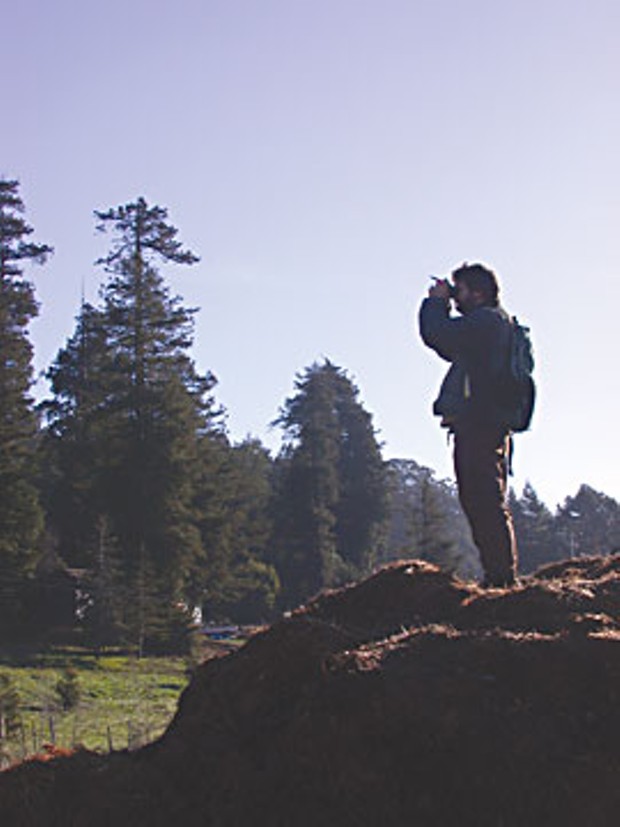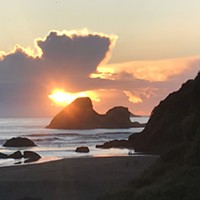[
{
"name": "Top Stories Video Pair",
"insertPoint": "7",
"component": "17087298",
"parentWrapperClass": "fdn-ads-inline-content-block",
"requiredCountToDisplay": "1"
}
]
Last summer, I went out with my friend Elias Elias to count marbled murrelets, the small, endangered water bird that nests on old-growth tree limbs. We tented the night before in the Prairie Creek campground and got up at 4 a.m. to count the birds as they left the forest for their salty breakfast at sea. We walked over to Elk Prairie, lay down in the grass and proceeded to stare up into the fog. It wasn't long before Elias, and then my wife Sara, exclaimed they saw the little duffers. "Okay. There's one!" exclaimed Elias matter-of-factly. Then my wife piped up, "Oh yeah. Ah ha. Cute." (Like that was a revelation.)
I continued to stare into the blank white registering nothing until I saw one, then many. My problem had been that I had been looking for something else, and neglected the evidence of what I was really seeing. It's like mushroom hunting. Sometime you need to see one before the rest of the objects become discernible from the ground. Fully expecting to see "birds" "flying" through the mist, I did not register the tiny little dark cigar-shaped bullets streaking by at more than 50 m.p.h. in the gloom.
Usually Elias tracks murrelets in the ocean. He goes out in a 26-foot skiff owned and operated by the Redwood Science Lab, his immediate employer. The lab acts as kind of a conduit for private and public money (collected from various state and federal programs, timber companies and foundations and grants). The team will cover five kilometers of shoreline each day, making multiple passes back and forth, starting at 400 meters off shore and going out to 3,000. "We count murrelets from both sides of the boat out to 100 meters in each direction and we note the distance to each sighting," Elias says. "That gives us the density and ultimately the population of an area." Every linear kilometer between the Canadian border and San Francisco has been covered this way.
Land birds (especially the smaller passerines, like sparrows) are counted audibly rather than visually. I once went out with Elias for a walk in Redwood National Park. Where I saw small brown flittering motions off the trail, Elias heard and counted three species of sparrows (Song, White Crowned and Golden Crowned).
"We do point counts," he explains. "We stand in one spot and listen and look for all the birds you can find in a really short period of time (five to 10 minutes) and give distance to each one. Then we move to the next one." Elias explains that he can cover between 13 and 18 different points in a day. The window for effective counting is only about one and a half months during the early breeding season. That's when the males "sing" (as opposed to "call") to attract mates and defend territories. Once Elias worked full time with four others and covered the entire South Fork of the Trinity River between Highway 299 and Highway 36 by (Hayfork and Hyampom). It took them almost two months.
I ask Elias what his ideal job would be and he simply says "to be a giant ear floating across the landscape just listening for birds." I then ask him what he would consider his most beautiful experience. He recollects a "backlit murrelet floating on placid water, its wake glittering behind it like fairy dust." Or a little stream course with tiny 1- to 2-foot waterfalls and little moss-covered boulders: "Life in miniature, like a Japanese garden." Then I ask him (as I am wont to) about his freakiest incident. This is what he describes.
"I was doing a survey on the Hoopa reservation. I had camped at an access point and was sleeping in back of my pickup truck without shell. It was the middle of the night and I was deep asleep."
He awoke to his truck being shaken violently from side to side.
"I sat bolt upright hearing nothing. No movement. No footsteps. No breeze. No earthquake." He explains that the trees would have been shaking for at least several seconds in the aftermath of a shock that violent.
"So my heart is racing, my palms sweating, and I am completely freaked out by this. I'm thinking that someone or something that shook the vehicle was perhaps under it. I was afraid to touch the ground."
Finally he managed to open the cab door from the bed of the truck and slither into the front seat.
"I locked the doors and fell asleep." He found no sign of anything in the morning.
Hey, Elias, now describe something really scary!
"In the early part of the career I was doing a lot of surveys deep in the forest." To identify the birds early when they are the most active, he had to be out on the trail before sunrise. On this particular day Elias had started at 2 a.m. to hike the five miles down a slope from his ridge-top camp. It was still pitch dark and he was walking with a headlamp.
"I was in the very dense tan oaks near where I was going to spend two hours counting birds. And then the hair literally stood up on the back of my neck." He had a vague sense that something was very close and making faint noises right next to him. So he stopped to listen, and then said out loud, "I do not want to see any bears." That had always worked in the past -- but not this time.
"It keeps making noises, cracking branches and breathing around me. So I immediately turn to climb a tree, any tree." It was still pitch black and the headlamp was on his head. As he climbed Elias heard it louder, now just on his right, very close.
"I had climbed up the tree only a short way when I looked above me to find the next branch to grab for." He craned his head back ... and the headlamp fell off to the ground below. He couldn't go higher because he couldn't see, but he was only five feet off the ground, his heels within swiping distance. "I had to go back down to get the light. I managed to grab it and climb back up again with it in my hands." The next time he heard the bear it was below him but now off to the left. That means the animal had circled the tree, or walked directly under him, or even right next to him when he was on the ground.
Speaking of Outdoors
more from the author
-
North to Alaska
In which Dan the Faller Man escapes the choker-setting life
- Mar 13, 2008
-
My Worst Job
In which Dan the Faller Man remembers his choker-setter days
- Feb 28, 2008
-
Ab Fab
Stalking the abalone, and living to tell the tale
- Feb 14, 2008
- More »



































